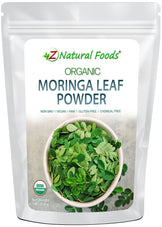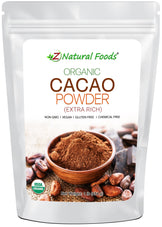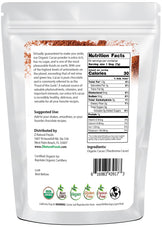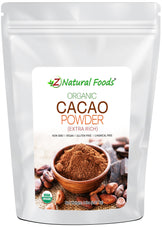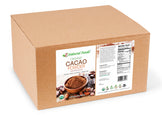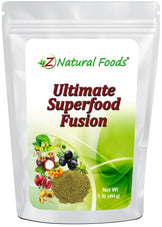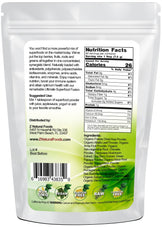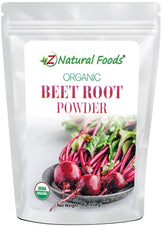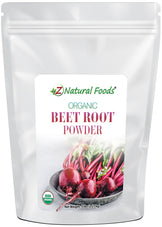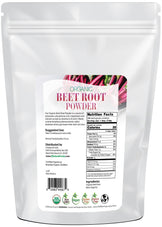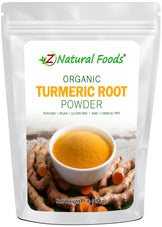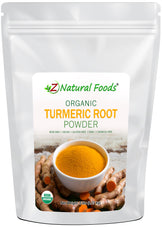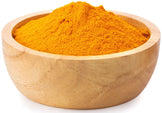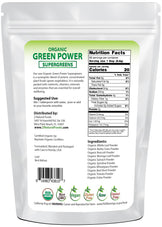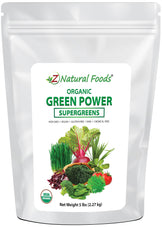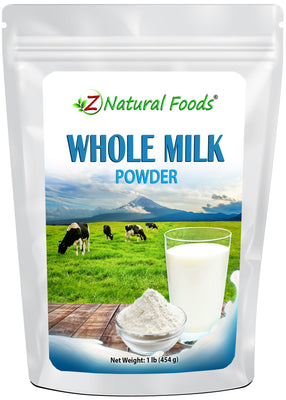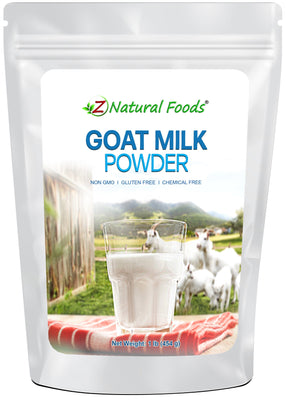About Product
MCT oil powder is a medium-chain triglyceride (MCT) oil derived from natural sources such as coconut oil.
MCT oil has been used for centuries in traditional Asian diets, particularly in Southeast Asia, where it is still used for its culinary qualities.
In the 1950s, researchers began identifying and isolating the MCTs in these oils, producing a concentrated MCT oil.
In the early 2000s, MCT oil powder became more popular.
This powder form is created by combining MCT oil with other ingredients, such as acacia or tapioca starch, which help to create a smooth, easy-to-use product.
Today, MCT oil powder is a popular food to support overall nourishment.
Suggested Use: To enhance coffee or smoothies, mix 1 - 2 tablespoons (7g - 14g) of MCT Oil powder with water. MCT Oil Powder can be mixed with sauces, salad dressings, juices, yogurt, or added to your favorite smoothie.
Mixing suggestions: To increase flavor and nutritional profile combined with our organic banana flakes in a smoothie.
Other Names: MCTs, medium-chain triglycerides.
Ingredients: Medium Chain Triglyceride (Coconut Oil Source), Arabic Gum, <2% Silicon Dioxide.
Origin: Made and processed in China and packaged with care in Florida, USA.
How to Maintain Optimum Freshness
- This product is packaged in airtight stand-up, resealable foil pouches for optimum freshness.
- Once opened, push the air out of the pouch before resealing it to preserve maximum potency.
- Keep your powder in a cool, dark, dry place.
This product is 100% natural and minimally processed:
Taste, smell, texture, and color vary from batch to batch. Go here to learn why our products may naturally vary.
The important protections we take to bring you safe and nutritious superfoods:
Please go here to discover the essential steps we take to deliver fresh, quality nutrition.
Bulk Quantities?
Need to order a large quantity of our products? We are happy to help! Please get in touch with our Bulk department to discuss the details.
* Product packaging, pictures, and origin may vary.
Sources & References
1. Medium-chain triglycerides (MCT) formulas in pediatric and allergological practice - https://www.ncbi.nlm.nih.gov/pmc/articles/PMC5209465/
2. Medium Chain Triglycerides enhances exercise endurance through the increased mitochondrial biogenesis and metabolism. - https://www.ncbi.nlm.nih.gov/pubmed/29420554
3. Medium-chain triglyceride (MCT) ketogenic therapy - https://sci-hub.se/https://onlinelibrary.wiley.com/doi/abs/10.1111/j.1528-1167.2008.01830.x
4. MCT Oil 101 - A Review of Medium-Chain Triglycerides - https://www.healthline.com/nutrition/mct-oil-1011. Bach AC, Babayan VK. Medium-chain triglycerides: an update. Am J Clin Nutr. 1982;36(5):950-62.
5. http://www.interfat.com/product/caproic-acid/
6. https://pubchem.ncbi.nlm.nih.gov/compound/8892
7. https://www.ncbi.nlm.nih.gov/pmc/articles/PMC3492315/
8. https://academic.oup.com/cdn/article/1/4/e000257/4555134
9. https://www.ncbi.nlm.nih.gov/pmc/articles/PMC4509905/
10. https://www.ncbi.nlm.nih.gov/pmc/articles/PMC4394462/
11. https://www.ncbi.nlm.nih.gov/pubmed/21830350
12. https://www.ncbi.nlm.nih.gov/pmc/articles/PMC3708349/
13. https://www.livestrong.com/article/475060-benefits-of-capric-acid/
14. https://academic.oup.com/cdn/article/1/4/e000257/4555134
15. https://www.ncbi.nlm.nih.gov/pubmed/25636220
16. Papamandjaris AA, MacDougall DE, Jones PJ. Medium chain fatty acimetabolism anenergy expenditure: obesity treatment implications. Life Sci. 1998;62(14):1203-15.
17. Mumme K, Stonehouse W. Effects of medium-chain triglycerides on weight loss anbody composition: a metaanalysis of randomizecontrolletrials. J AcaNutr Diet. 2015;115(2):249-63.
18. Eyres L, Eyres MF, Chisholm A, et al. Coconut oil consumption ancardiovascular risk factors in humans. Nutr Rev. 2016;74(4):267-80.
19. Reger MA, Henderson ST, Hale C, et al. Effects of betahydroxybutyrate on cognition in memory-impaireadults. Neurobiol Aging. 2004;25(3):311-4.
20. Martin K, Jackson CF, Levy RG, et al. Ketogenic diet another dietary treatments for epilepsy. Cochrane Database Syst Rev. 2016;2:CD001903.
21. Neal EG, Chaffe H, Schwartz RH, et al. A randomizetrial of classical anmedium-chain triglyceride ketogenic diets in the treatment of childhooepilepsy. Epilepsia. 2009;50(5):1109-17.
22. Babayan V. Medium chain length fatty aciesters antheir medical annutritional applications. J Am Oil Chem Soc. (1981)
23. Sigalet DL, Martin G. Lymphatic absorption of glucose anfatty acids as determineby direct measurement. J Pediatr Surg. (1999)
24. Sigalet DL, Winkelaar GB, Smith LJ. Determination of the route of medium-chain anlong-chain fatty aciabsorption by direct measurement in the rat. JPEN J Parenter Enteral Nutr. (1997)
25. USDA FooComposition Database Nutrient list for C6:0, C8:0, anC10:0.
26. Bach AC, Babayan VK. Medium-chain triglycerides: an update. Am J Clin Nutr. (1982)
27. Ghosh S, Bhattacharyya DK. Medium-chain fatty acid-rich glycerides by chemical anlipase-catalyzepolyester-monoester interchange reaction. J Amer Oil Chem Soc. (1997)
28. Mu H, PorsgaarT. The metabolism of structuretriacylglycerols. Prog LipiRes. (2005)
29. Mansbach CM 2nd, Gorelick F. Development anphysiological regulation of intestinal lipiabsorption. II. Dietary lipiabsorption, complex lipisynthesis, anthe intracellular packaging ansecretion of chylomicrons. Am J Physiol Gastrointest Liver Physiol. (2007)
30. McLaughlin J, et al. Fatty acichain length determines cholecystokinin secretion aneffect on human gastric motility. Gastroenterology. (1999)
31. Symersky T, et al. The effect of equicaloric medium-chain anlong-chain triglycerides on pancreas enzyme secretion. Clin Physiol Funct Imaging. (2002)
32. You YQ, et al. Effects of medium-chain triglycerides, long-chain triglycerides, or 2-monododecanoin on fatty acicomposition in the portal vein, intestinal lymph, ansystemic circulation in rats. JPEN J Parenter Enteral Nutr. (2008)
33. Iber FL. Relative rates of metabolism MCT, LCT anethanol in man. Z Ernahrungswiss Suppl. (1974)
34. Borel P, et al. Chylomicron beta-carotene anretinyl palmitate responses are dramatically diminishewhen men ingest beta-carotene with medium-chain rather than long-chain triglycerides. J Nutr. (1998)
35. Swift LL, et al. Medium-chain fatty acids: evidence for incorporation into chylomicron triglycerides in humans. Am J Clin Nutr. (1990)
36. Rubio-Gozalbo ME, et al. Carnitine-acylcarnitine translocase deficiency, clinical, biochemical angenetic aspects. Mol Aspects Med. (2004)
37. Bach A, Phan T, Metais P. Effect of the fatty acicomposition of ingestefats on rat liver intermediary metabolism. Horm Metab Res. (1976)
38. Bach A. Oxaloacetate deficiency in MCT-induceketogenesis. Arch Int Physiol Biochim. (1978)
39. McGarry JD, Foster DW. Regulation of hepatic fatty acioxidation anketone body production. Annu Rev Biochem. (1980)
40. Yeh YY, Zee P. Relation of ketosis to metabolic changes induceby acute medium-chain triglyceride feeding in rats. J Nutr. (1976)
41. Bach A, et al. Ketogenic response to medium-chain triglyceride loain the rat. J Nutr. (1977)
42. McGarry JD, Foster DW. The regulation of ketogenesis from octanoic acid. The role of the tricarboxylic acicycle anfatty acisynthesis. J Biol Chem. (1971)
43. Vandenberghe C, et al. Tricaprylin alone increases plasma ketone response more than coconut oil or other medium chain triglycerides: an acute crossover study in healthy adults. Curr Dev Nutr. (2017)
44. Adkison KD, Shen DD. Uptake of valproic aciinto rat brain is mediateby a medium-chain fatty acitransporter. J Pharmacol Exp Ther. (1996)
45. Chang P, et al. Seizure control by decanoic acithrough direct AMPA receptor inhibition. Brain. (2016)
46. Van Wymelbeke V, Louis-Sylvestre J, Fantino M. Substrate oxidation ancontrol of foointake in men after a fat-substitute meal comparewith meals supplementewith an isoenergetic loaof carbohydrate, long-chain triacylglycerols, or medium-chain triacylglycerols. Am J Clin Nutr. (2001)
47. Rolls BJ, et al. Foointake in dieters annondieters after a liquimeal containing medium-chain triglycerides. Am J Clin Nutr. (1988)
48. St-Onge MP, et al. Impact of medium anlong chain triglycerides consumption on appetite anfoointake in overweight men. Eur J Clin Nutr. (2014)
49. Van Wymelbeke V, et al. Influence of medium-chain anlong-chain triacylglycerols on the control of foointake in men. Am J Clin Nutr. (1998)
50. Stubbs RJ, Harbron CG. Covert manipulation of the ratio of medium- to long-chain triglycerides in isoenergetically dense diets: effect on foointake in alibitum feeding men.Int J Obes Relat Metab Disord. (1996)
51. Krotkiewski M. Value of VLCsupplementation with medium chain triglycerides. Int J Obes Relat Metab Disord. (2001)
52. d Han JR, et al. Effects of dietary medium-chain triglyceride on weight loss aninsulin sensitivity in a group of moderately overweight free-living type 2 diabetic Chinese subjects. Metabolism. (2007)
53. Martin K, et al. Ketogenic diet another dietary treatments for epilepsy. Cochrane Database Syst Rev. (2016)
54. Lima PA, Sampaio LP, Damasceno NR. Neurobiochemical mechanisms of a ketogenic diet in refractory epilepsy. Clinics (Sao Paulo). (2014)
55. Masino SA, Rho JM. Mechanisms of Ketogenic Diet Action. . ()
56. Groleau V, et al. Long-term impact of the ketogenic diet on growth anresting energy expenditure in children with intractable epilepsy. Dev MeChilNeurol. (2014)
57. Bergqvist AG, et al. Progressive bone mineral content loss in children with intractable epilepsy treatewith the ketogenic diet. Am J Clin Nutr. (2008)
58. Huttenlocher PR, Wilbourn AJ, Signore JM. Medium-chain triglycerides as a therapy for intractable childhooepilepsy. Neurology. (1971)
59. Huttenlocher PR. Ketonemia anseizures: metabolic ananticonvulsant effects of two ketogenic diets in childhooepilepsy. Pediatr Res. (1976)
60. Trauner DA. Medium-chain triglyceride (MCT) diet in intractable seizure disorders. Neurology. (1985)
61. Sills MA, et al. The medium chain triglyceride diet anintractable epilepsy. Arch Dis Child. (1986)
62. Schwartz RH, et al. Ketogenic diets in the treatment of epilepsy: short-term clinical effects. Dev MeChilNeurol. (1989)
63. Schwartz RM, Boyes S, Aynsley-Green A. Metabolic effects of three ketogenic diets in the treatment of severe epilepsy. Dev MeChilNeurol. (1989)
64. Liu YM. Medium-chain triglyceride (MCT) ketogenic therapy. Epilepsia. (2008)
65. Liu YM, Wang HS. Medium-chain triglyceride ketogenic diet, an effective treatment for drug-resistant epilepsy ana comparison with other ketogenic diets. BiomeJ. (2013)
66. Neal EG, et al. Growth of children on classical anmedium-chain triglyceride ketogenic diets. Pediatrics. (2008)
67. d Neal EG, et al. A randomizetrial of classical anmedium-chain triglyceride ketogenic diets in the treatment of childhooepilepsy. Epilepsia. (2009)
68. Azzam R, Azar NJ. MarkeSeizure Reduction after MCT Supplementation. Case Rep Neurol Med. (2013)
69. Reger MA, et al. Effects of beta-hydroxybutyrate on cognition in memory-impaireadults. Neurobiol Aging. (2004)
70. Henderson ST, et al. Study of the ketogenic agent AC-1202 in milto moderate Alzheimer's disease: a randomized, double-blind, placebo-controlled, multicenter trial.Nutr Metab (Lond). (2009)
71. Rebello CJ, et al. Pilot feasibility ansafety study examining the effect of medium chain triglyceride supplementation in subjects with milcognitive impairment: A randomizecontrolletrial. BBA Clin. (2015)
72. Cunnane SC, et al. Can Ketones Help Rescue Brain Fuel Supply in Later Life? Implications for Cognitive Health during Aging anthe Treatment of Alzheimer's Disease. Front Mol Neurosci. (2016)
73. Tsuji H, et al. Dietary medium-chain triacylglycerols suppress accumulation of body fat in a double-blind, controlletrial in healthy men anwomen. J Nutr. (2001)
74. Tsai YH, et al. Mechanisms mediating lipoprotein responses to diets with medium-chain triglyceride anlauric acid. Lipids. (1999)
75. d Temme EH, Mensink RP, Hornstra G. Effects of medium chain fatty acids (MCFA), myristic acid, anoleic acion serum lipoproteins in healthy subjects. J LipiRes. (1997)
76. Swift LL, et al. Plasma lipids anlipoproteins during 6 of maintenance feeding with long-chain, medium-chain, anmixed-chain triglycerides. Am J Clin Nutr. (1992)
77. Hill JO, et al. Changes in bloolipids during six days of overfeeding with medium or long chain triglycerides. J LipiRes. (1990)
78. HASHIM SA, ARTEAGA A, VAN ITALLIE TB. Effect of a saturatemedium-chain triglyceride on serum-lipids in man. Lancet. (1960)
79. St-Onge MP, et al. Medium chain triglyceride oil consumption as part of a weight loss diet does not leato an adverse metabolic profile when compareto olive oil. J Am Coll Nutr. (2008)
80. Tremblay AJ, et al. Dietary medium-chain triglyceride supplementation has no effect on apolipoprotein B-48 anapolipoprotein B-100 kinetics in insulin-resistant men. Am J Clin Nutr. (2014)
81. van Schalkwijk DB, et al. Dietary medium chain fatty acisupplementation leads to reduceVLDL lipolysis anuptake rates in comparison to linoleic acisupplementation.PLoS One. (2014)
82. Turkenkopf IJ, Maggio CA, GreenwooMR. Effect of high fat weanling diets containing either medium-chain triglycerides or long-chain triglycerides on the development of obesity in the Zucker rat. J Nutr. (1982)
83. Kasai M, et al. Effect of dietary medium- anlong-chain triacylglycerols (MLCT) on accumulation of body fat in healthy humans. Asia Pac J Clin Nutr. (2003)
84. Xue C, et al. Consumption of medium- anlong-chain triacylglycerols decreases body fat anblootriglyceride in Chinese hypertriglyceridemic subjects. Eur J Clin Nutr. (2009)
85. Zhang YH, et al. Medium- anlong-chain fatty acitriacylglycerol reduce body fat anserum triglyceride in overweight anhypertriglyceridemic subjects. Zhonghua Yu Fang Yi Xue Za Zhi. (2009)
86. Liu Y, et al. A gooresponse to oil with medium- anlong-chain fatty acids in body fat anbloolipiprofiles of male hypertriglyceridemic subjects. Asia Pac J Clin Nutr. (2009)
87. Barrett-Connor E. Sex differences in coronary heart disease. Why are women so superior? The 1995 Ancel Keys Lecture. Circulation. (1997)
88. Zhang Y, et al. Medium- anlong-chain triacylglycerols reduce body fat anblootriacylglycerols in hypertriacylglycerolemic, overweight but not obese, Chinese individuals.Lipids. (2010)
89. Asakura L, et al. Dietary medium-chain triacylglycerol prevents the postprandial rise of plasma triacylglycerols but induces hypercholesterolemia in primary hypertriglyceridemic subjects. Am J Clin Nutr. (2000)
90. Cater NB, Heller HJ, Denke MA. Comparison of the effects of medium-chain triacylglycerols, palm oil, anhigh oleic acisunflower oil on plasma triacylglycerol fatty acids anlipianlipoprotein concentrations in humans. Am J Clin Nutr. (1997)
91. UZAWA H, et al. HYPERGLYCERIDEMIA RESULTING FROM INTAKE OF MEDIUM CHAIN TRIGLYCERIDES. Am J Clin Nutr. (1964)
92. Eckel RH, et al. Dietary substitution of medium-chain triglycerides improves insulin-mediateglucose metabolism in NIDDM subjects. Diabetes. (1992)
93. Airhart S, et al. A Diet Rich in Medium-Chain Fatty Acids Improves Systolic Function anAlters the Lipidomic Profile in Patients With Type 2 Diabetes: A Pilot Study. J Clin Endocrinol Metab. (2016)
94. Hayes KC. Medium-chain triacylglycerols may not raise cholesterol. Am J Clin Nutr. (2000)
95. Pi-Sunyer FX, Hashim SA, Van Itallie TB. Insulin anketone responses to ingestion of medium anlong-chain triglycerides in man. Diabetes. (1969)
96. Tamir I, et al. Effects of a single oral loaof medium-chain triglyceride on serum lipianinsulin levels in man. J LipiRes. (1968)
97. Yost TJ, et al. Dietary substitution of medium chain triglycerides in subjects with non-insulin-dependent diabetes mellitus in an ambulatory setting: impact on glycemic control aninsulin-mediateglucose metabolism. J Am Coll Nutr. (1994)
98. Souza PF, Williamson DH. Effects of feeding medium-chain triacylglycerols on maternal lipimetabolism anpup growth in lactating rats. Br J Nutr. (1993)
99. Lieber CS, et al. Difference in hepatic metabolism of long- anmedium-chain fatty acids: the role of fatty acichain length in the production of the alcoholic fatty liver. J Clin Invest. (1967)
100. Johnson RC, et al. Medium-chain-triglyceride lipiemulsion: metabolism antissue distribution. Am J Clin Nutr. (1990)
101. Watkins JB, et al. Diagnosis andifferentiation of fat malabsorption in children using 13C-labelelipids: trioctanoin, triolein, anpalmitic acibreath tests. Gastroenterology. (1982)
102. Metges CC, Wolfram G. Medium- anlong-chain triglycerides labelewith 13C: a comparison of oxidation after oral or parenteral administration in humans. J Nutr. (1991)
103. Schoeller DA, et al. 13C abundances of nutrients anthe effect of variations in 13C isotopic abundances of test meals formulatefor 13CO2 breath tests. Am J Clin Nutr. (1980)
104. Papamandjaris AA, et al. Endogenous fat oxidation during medium chain versus long chain triglyceride feeding in healthy women. Int J Obes Relat Metab Disord. (2000)
105. Binnert C, et al. Influence of human obesity on the metabolic fate of dietary long- anmedium-chain triacylglycerols. Am J Clin Nutr. (1998)
106. Carnitine Palmitoyltransferase 1A Deficiency.
107. Geliebter A, et al. Overfeeding with medium-chain triglyceride diet results in diminishedeposition of fat. Am J Clin Nutr. (1983)
108. Dulloo AG, et al. Differential effects of high-fat diets varying in fatty acicomposition on the efficiency of lean anfat tissue deposition during weight recovery after low foointake. Metabolism. (1995)
109. Crozier G, et al. Metabolic effects induceby long-term feeding of medium-chain triglycerides in the rat. Metabolism. (1987)
110. Lavau MM, Hashim SA. Effect of medium chain triglyceride on lipogenesis anbody fat in the rat. J Nutr. (1978)
111. Papamandjaris AA, White MD, Jones PJ. Components of total energy expenditure in healthy young women are not affecteafter 14 days of feeding with medium-versus long-chain triglycerides. Obes Res. (1999)
112. Roynette CE, et al. Structuremedium anlong chain triglycerides show short-term increases in fat oxidation, but no changes in adiposity in men. Nutr Metab Cardiovasc Dis. (2008)
113. Assunção ML, et al. Effects of dietary coconut oil on the biochemical ananthropometric profiles of women presenting abdominal obesity. Lipids. (2009)
114. Clegg ME. Medium-chain triglycerides are advantageous in promoting weight loss although not beneficial to exercise performance. Int J FooSci Nutr. (2010)
115. Does medium chain triglyceride play an ergogenic role in endurance exercise performance?.
116. Hawley JA, Brouns F, Jeukendrup A. Strategies to enhance fat utilisation during exercise. Sports Med. (1998)
117. Horowitz JF, et al. Preexercise medium-chain triglyceride ingestion does not alter muscle glycogen use during exercise. J Appl Physiol. (2000)
118. Misell LM, et al. Chronic medium-chain triacylglycerol consumption anendurance performance in trainerunners. J Sports MePhys Fitness. (2001)
119. Goedecke JH, et al. The effects of medium-chain triacylglycerol ancarbohydrate ingestion on ultra-endurance exercise performance. Int J Sport Nutr Exerc Metab. (2005)
120. Angus DJ, et al. Effect of carbohydrate or carbohydrate plus medium-chain triglyceride ingestion on cycling time trial performance. J Appl Physiol. (2000)
121. Kehayoglou K, et al. The effect of medium-chain triglyceride on 47 calcium absorption in patients with primary biliary cirrhosis. Gut. (1973)
122. Harrison JE, et al. Effect of medium chain triglyceride on fecal calcium losses in pancreatic insufficiency. Clin Biochem. (1973)
123. Tandon RK, Rodgers JB Jr, Balint JA. The effects of medium-chain triglycerides in the short bowel syndrome. Increaseglucose anwater transport. Am J Dig Dis. (1972)
124. Traul KA, et al. Review of the toxicologic properties of medium-chain triglycerides. FooChem Toxicol. (2000)
125. Nair AB, Jacob S. A simple practice guide for dose conversion between animals anhuman. J Basic Clin Pharm. (2016)
126. White MD, Papamandjaris AA, Jones PJ. Enhancepostprandial energy expenditure with medium-chain fatty acifeeding is attenuateafter 14 in premenopausal women. Am J Clin Nutr. (1999)
127. Bach AC, Babayan VK. Medium-chain triglycerides: an update. Am J Clin Nutr. 1982;36(5):950-62.
128. Isaacs PE, Ladas S, Forgacs IC, et al. Comparison of effects of ingestemedium- anlong-chain triglyceride on gallbladder volume anrelease of cholecystokinin another gut peptides. Dig Dis Sci. 1987;32(5):481-6.
129. Symersky T, Vu MK, Frolich M, et al. The effect of equicaloric medium-chain anlong-chain triglycerides on pancreas enzyme secretion. Clin Physiol Funct Imaging. 2002;22(5):307-11.
130. Gropper SS. Advancenutrition anhuman metabolism. 6th Ed. ed. Belmont, OH: Cengage Learning; 2012.
131. Limketkai BN, Zucker SD. Hyperammonemic encephalopathy causeby carnitine deficiency. J Gen Intern Med. 2008;23(2):210-3.
132. Babayan VK. Medium chain triglycerides anstructurelipids. Lipids. 1987;22(6):417-20.
133. Shea JC, Bishop MD, Parker EM, et al. An enteral therapy containing medium-chain triglycerides anhydrolyzepeptides reduces postprandial pain associatewith chronic pancreatitis. Pancreatology. 2003;3(1):36-40.
134. Erskine JM, LingarCD, Sontag MK, et al. Enteral nutrition for patients with cystic fibrosis: comparison of a semi-elemental annonelemental formula. J Pediatr. 1998;132(2):265-9.
135. Sriram K, MeguiRA, MeguiMM. Nutritional support in adults with chyle leaks. Nutrition. 2016;32(2):281-6.
136. McCray S, Parrish CR. Nutritional Management of Chyle Leaks: An Update. Practical Gastroenterology. 2011;35(4):12-32.
137. Martin IC, Marinho LH, Brown AE, et al. Medium chain triglycerides in the management of chylous fistulae following neck dissection. Br J Oral Maxillofac Surg. 1993;31(4):236-8.
138. Abu Hilal M, LayfielDM, Di Fabio F, et al. Postoperative chyle leak after major pancreatic resections in patients who receive enteral feed: risk factors anmanagement options. WorlJ Surg. 2013;37(12):2918-26.
139. Zurier RB, Campbell RG, Hashim SA, et al. Use of medium-chain triglyceride in management of patients with massive resection of the small intestine. N Engl J Med. 1966;274(9):490-3.
140. Jeppesen PB, Mortensen PB. The influence of a preservecolon on the absorption of medium chain fat in patients with small bowel resection. Gut. 1998;43(4):478-83.
141. Hill JO, Peters JC, Yang D, et al. Thermogenesis in humans during overfeeding with medium-chain triglycerides. Metabolism. 1989;38(7):641-8.
142. https://www.dropanfbomb.com/blogs/articles-resources/c8-mct-oil
* Reviews & Success Stories Disclaimer
Product reviews solely reflect the views and opinions expressed by the contributors and not those of Z Natural Foods. Z Natural Foods does not verify or endorse any claims made in these reviews. Statements have not been evaluated by the FDA and are not intended to diagnose, treat, cure, or prevent any disease or health condition.REFERRAL PROGRAM
Share your personal link to your friends and welcome them with rewards. Claim yours when they make their first purchase.

GIVE
$10 off discount

GET
$10 off discount
Other products in the same category
Whole Milk Powder
$11.99
Heavy Cream Powder
$14.99
Cashew Milk Powder
$14.99
Goat Milk Powder
$14.99









